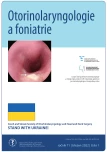Isolated lesion of the hypoglossal nerve as the result of an internal carotid artery aneurysm – case report
Authors:
Tóthová Ž. 1; Sláviková K. 2; Siváková M. 3; I. Vulev 4
; Miroslav Tedla 5,6
Authors place of work:
Lekárska fakulta UK v Bratislave
1; Rádiológia, s. r. o., Bratislava
2; I. neurologická klinika LF UK a UN Bratislava
3; Nemocnica CINRE (Centrum intervenčnej neurorádiológie a endovaskulárnej liečby), Bratislava
4; Klinika otorinolaryngológie a chirurgie hlavy a krku LF UK a UN Bratislava
5; Institute of Cancer and Genomic Sciences, University of Birmingham, United Kingdom
6
Published in the journal:
Otorinolaryngol Foniatr, 71, 2022, No. 1, pp. 44-47.
Category:
Kazuistika
doi:
https://doi.org/10.48095/ccorl202244
Summary
A 56-year-old male with arterial hypertension sought for medical help for a sudden unilateral swelling of the oral tongue and changed quality of speech. An ENT examination revealed a lesion of the left hypoglossal nerve. Neurological examinations including brain imaging showed negative results. The MRI of the neck only suggested, the angiography confirmed internal carotid aneurysm in the extracranial portion causing pressure on the hypoglossal nerve. The aneurysm was treated with a flow diverter, which reroutes the blood flow and thus embolises the aneurysm. The aneurysm shrunk, its mass effect disappeared and the function of the nerve fully recovered.
Keywords:
case report – hypoglossal nerve – a. carotis interna – sudden appeared lesion
Zdroje
1. Čihák R. Anatomie 3. 2. vyd. Praha: Grada 2004.
2. Kim SY, Naqvi IA. Neuroanatomy, cranial nerve 12 (Hypoglossal). In: StatPearls, Treasure Island (FL): StatPearls Publishing LLC 2021.
3. Ambler Z, Bednařík J, Růžička E. Klinická neurologie. 1. část obecná. Praha: Triton 2008.
4. Ambler Z. Neurologie pro studenty lékařské fakulty. 1. vyd. Praha: Karolinum 2001.
5. Finsterer J, Grisold W. Disorders of the lower cranial nerves. J Neurosci Rural Pract 2015; 6 (3): 377–391. Doi: 10.4103/0976-3147.158768.
6. Yoon JH, Cho KL, Lee HJ et al. A case of idiopathic isolated hypoglossal nerve palsy in a Korean child. Korean J Pediatr 2011; 54 (12): 515–517. Doi: 10.3345/kjp.2011.54.12.515.
7. Altun G, Pulathan Z, Hemsinli D. True aneurysms of the extracranial carotid artery: An evaluation of two “giant aneurysms” and the current literature. J Korean Neurosurg Soc 2018; 61 (2): 282–286. Doi: 10.3340/jkns.2017.0404.003.
8. Brain Aneurysm Foundation: Endovascular Treatment. [online]. Dostupné z: https: //www.bafound.org/treatment/endovascular-treatment/.
9. Briganti F, Leone G, Marseglia M et al. Endovascular treatment of cerebral aneurysms using flow-diverter devices: A systematic review. Neuroradiol J 2015; 28 (4): 365–375. Doi: 10.1177/1971400915602803.
10. Vulev I, Šteňo J, Bízik I et al. Aktuálne koncepty endovaskulárnej liečby intrakraniálnych aneuryziem. Vask med 2010; 2 (2): 68–73.
Štítky
Audiologie a foniatrie Dětská otorinolaryngologie OtorinolaryngologieČlánek vyšel v časopise
Otorinolaryngologie a foniatrie

2022 Číslo 1
Nejčtenější v tomto čísle
- Izolovaná lézia n. hypoglossus ako dôsledok aneuryzmy arteria carotis interna – kazuistika
- Adaptace a validace české verze dotazníku pro hodnocení příznaků nosní obstrukce (NOSE-cz)
- Mikroprostředí spinocelulárního karcinomu hlavy a krku jako analogie hojící se rány
- Koincidence bilaterálního Warthinova tumoru příušních žláz a epitelio-myoepiteliálního karcinomu parafaryngu
